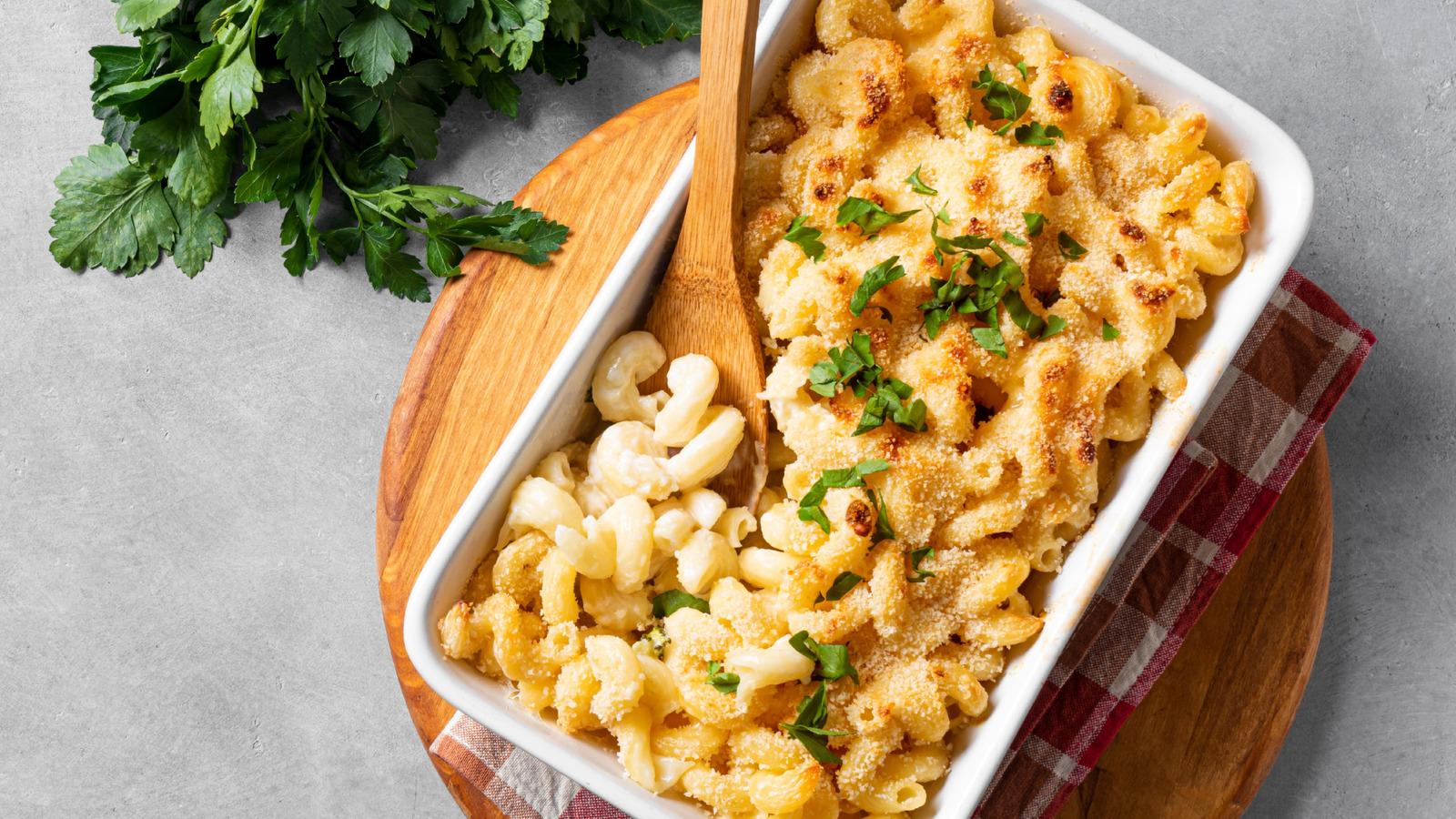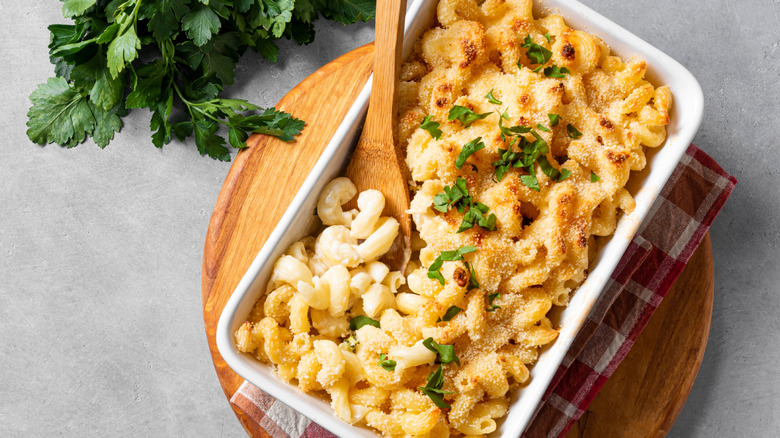
Oksana Mizina/Shutterstock
Mac and cheese is a classic for a reason, with its creamy, cheesy sauce. It seems like something that would be easy enough to make well at home — especially once you've ditched the boxed stuff — but mac and cheese from a restaurant always hits different. It's often richer and more complex than the version you make yourself. It's way more than just nostalgia, making you want to visit again and again, always ordering the same thing off the menu. But why is mac and cheese from restaurants tastier?
The truth is, restaurant mac and cheese benefits from a lot of small advantages that add up. Professional chefs lean into techniques and ingredients that most home cooks skip, either because they don't know about them or they're trying to keep things fast and easy. But once you know the tricks, it's a gateway to better mac and cheese.
We're about to give you the lowdown on why mac and cheese always tastes better at a restaurant. From careful cheese choices to extra flavorful ingredients that blend into the finished dish so well that you wouldn't pick them out, there's more to a restaurant quality version than you might imagine. Once you know the chef secrets, there's no stopping you from making incredible mac and cheese recipes in your own kitchen.
Restaurant mac and cheese starts with a roux
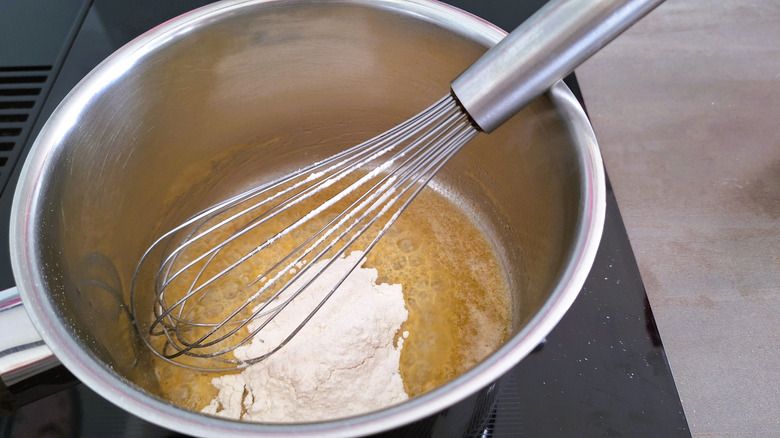
kmh72/Shutterstock
Most restaurant-style mac and cheese is made with a béchamel sauce — one of the classic "mother sauces" in French cuisine. But, you have to start somewhere, and that's with a roux. This is the base of that creamy sauce the dish is known for.
A roux is just fat and flour cooked together. It doesn't sound exciting, but it's where everything begins for a perfect mac and cheese. When chefs make a roux, they're doing two important things: building flavor and ensuring the cheese sauce stays smooth and stable. If you've ever made mac and cheese at home and ended up with a grainy or separated sauce, chances are you skipped or rushed this step.
Most restaurants use butter for the roux, though some might use a combination of butter and oil. The chef cooks the flour just long enough to get rid of its raw taste, but not so long that it darkens too much. Getting a little toastiness to the roux helps to build layers of great flavor, though. Once the roux is toasted, the cook gradually whisks in milk to form a velvety base.
This slow and steady process helps emulsify the cheese when it gets added later. It also gives the sauce body. At home, it's tempting to just melt cheese into hot noodles with a splash of milk. But that's not what the pros do. They start with a roux and go from there.
Chefs may use warm milk in their béchamel
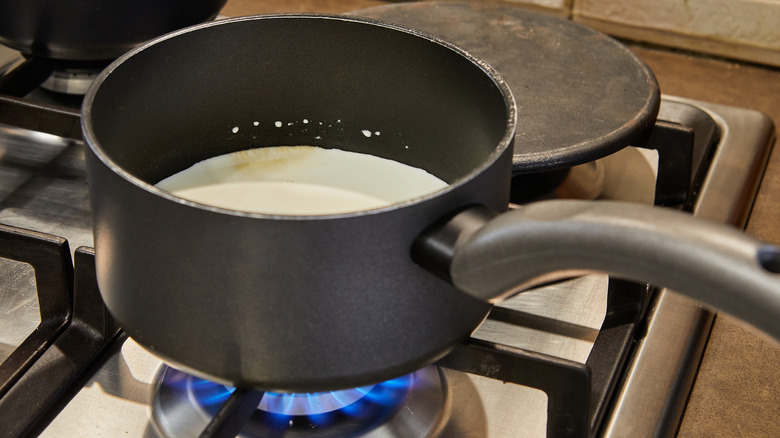
Alexander Donin/Getty Images
Here's one of those cheeky little chef moves that makes a big difference: warming the milk before adding it to the roux. It sounds fussy, but it changes everything. It's a simple step — especially if you have a microwave — but one that gives you much more consistent results.
When you pour cold milk into a hot roux, the temperature drop can cause lumps or slow down the thickening process. Warm milk, however, blends in smoothly and helps the sauce come together more quickly. That means a smoother texture and fewer chances for something to go wrong. Chefs aren't just being fancy when they do this, they're being efficient and setting themselves up for success.
Some may even infuse the milk with aromatics before using it. Onion, bay leaf, and nutmeg can all subtly boost the flavor without calling too much attention to themselves. You're not meant to taste those notes outright. Rather, they add to the overall deliciousness of the sauce, adding something you can't quite put your finger on but elevates things above standard homemade versions.
At home, it's easy to skip this step and pour your milk into the pan straight from your fridge. But once you try warming your milk, you'll notice your cheese sauce behaves differently. It's smoother, more cohesive, and gives you restaurant vibes.
Professionals often add cream to their mac and cheese
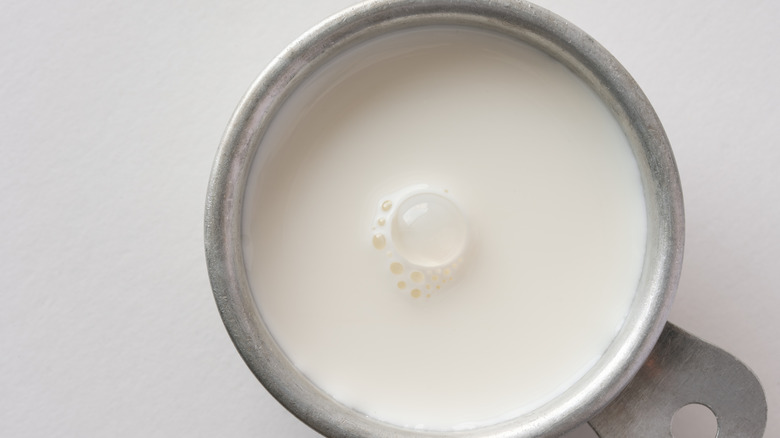
Michelle Lee Photography/Getty Images
One reason restaurant mac and cheese feels so rich and decadent is what goes in the béchamel. It's not just milk in that sauce; there's often cream in the mix, too. This is one of those tips for making the creamiest mac and cheese ever.
Chefs know that the higher the fat content, the creamier the final dish. Whole milk can get you part of the way there, but adding heavy cream makes the dish richer and more delicious, and helps the sauce cling to the pasta. It also helps stop it from splitting when the cheese goes in.
That doesn't mean it's all cream, all the time — most chefs use a blend. Milk provides fluidity, while cream adds body. It's all about moderation. If you were to use just heavy cream, the finished dish may end up sickeningly rich, but using roughly half milk, half cream gives you that balance — rich, but not too rich.
At home, it's common to stick to just milk because you already have it in the fridge or to keep things lighter. But if you've ever wondered why your mac and cheese seems thinner or less velvety than the one from your favorite bistro, this could be the reason.
Restaurant mac and cheese may use more sauce and contain more cheese than homemade
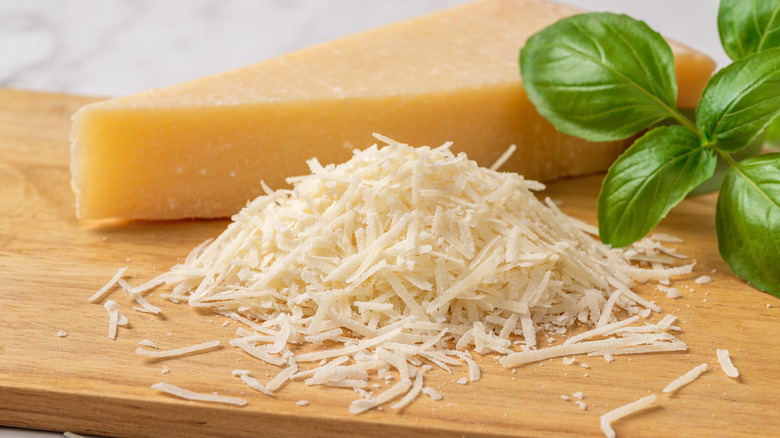
Maryia_K/Shutterstock
If you've ever found yourself with dry or clumpy mac and cheese a few minutes after serving, you're not alone. One of the secrets behind restaurant-style mac is simple: more sauce. At home, many people are too stingy with the sauce, but it can leave you with disappointing results.
Chefs tend to go heavy on the sauce-to-pasta ratio. Pasta keeps absorbing liquid after it's cooked. By giving it extra sauce from the start, the final dish stays creamy rather than drying out. This way you get plenty of creamy sauce to go with your noodles — and that's what we all want.
Pros also tend to use more cheese than you might at home. When you're cooking for yourself, you might find yourself grating half a block and calling it good enough. But in restaurants, they don't hold back. Mac and cheese there is often packed with more cheese than you'd guess.
Mac and cheese from restaurants may contain anywhere from a ½ cup to 1 cup of shredded cheese per serving, depending on the dish. That's a lot more than most home recipes call for, but it's part of the reason a chef's mac tastes more intensely cheesy and feels more cohesive. Yes, it's a lot of cheese to eat in one sitting, but unless you're eating mac every day, it's not something you have to worry about.
Chefs choose their cheeses carefully
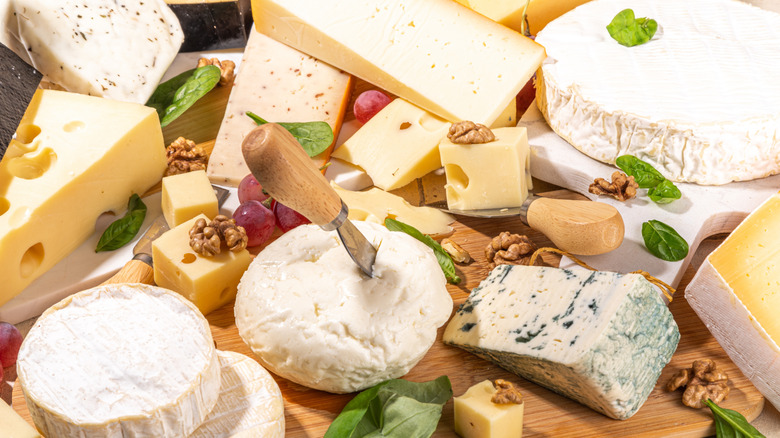
Rimma Bondarenko/Shutterstock
Not all cheeses melt the same, and that's something chefs are deeply aware of when they're building a good mac and cheese. At home, it's easy to just use whatever's in the fridge. But chefs are meticulous about what they use. Restaurant versions often taste more balanced and have better texture because the cheese blend was chosen with purpose.
But this is subjective and changes between chefs — part of the reason why no two mac and cheeses are identical. Some chefs say that a classic cheddar cheese is the only way to go. Perhaps mixed with a little Parmesan to give you that iconic mac and cheese flavor.
However, most of the time, recipes contain a mix of cheeses — some for flavor, some for texture, some for both. Sharp cheddar is a classic choice because of its strong taste, but it doesn't melt particularly well on its own. But for the best mac and cheese, you need to think about the melt factor, choosing cheeses that give your sauce a creamy finish. That's where cheeses like mozzarella, Monterey Jack, and fontina come in.
Some chefs say there's an ideal formula for cheese choice: a base cheese like cheddar or Jack, a funky cheese like fontina or French raclette, and an aged cheese like Parmesan or pecorino. There's no single right answer here, so you'll need to experiment.
Mac and cheese from a restaurant is made with cheese grated by hand
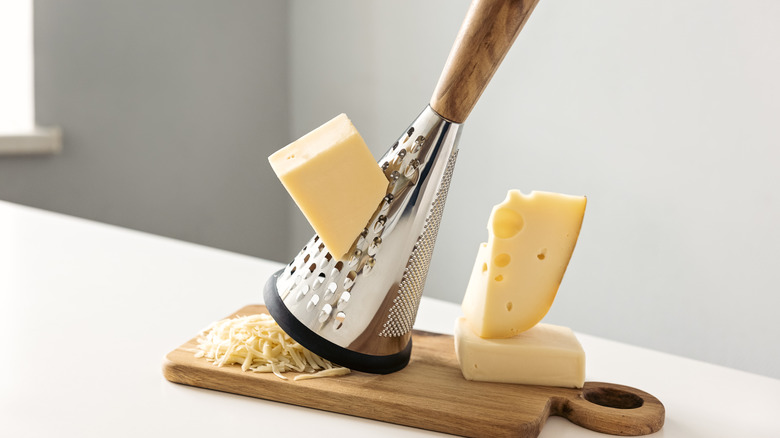
Mrs/Getty Images
You've been making your mac and cheese wrong all of these years — and one of those mistakes is using pre-shredded cheese. It's a small detail, but it has a big impact. Restaurants almost always grate their own cheese. Not because they're trying to be artisanal, but because pre-shredded cheese doesn't behave the same way.
Bagged cheese is coated with anti-caking agents to keep it from clumping. That's great for sprinkling on tacos, but it's not ideal when you're trying to make a smooth, melty sauce. Those coatings can stop cheese from fully melting, so you end up with a grainy or chalky texture.
Freshly grated cheese, on the other hand, melts more cleanly and blends more easily into béchamel. It also tends to taste better. It may be fresher, milkier, or sharper, depending on the cheese. Restaurants usually grate cheese in bulk before service, so it's ready to go when it's time to make a dish. At home, it can feel like a hassle, especially if you're in a rush. But if you're chasing that silky, restaurant-style texture, it's worth pulling out the box grater.
Restaurant mac and cheese is made with pasta that's well-salted and slightly undercooked
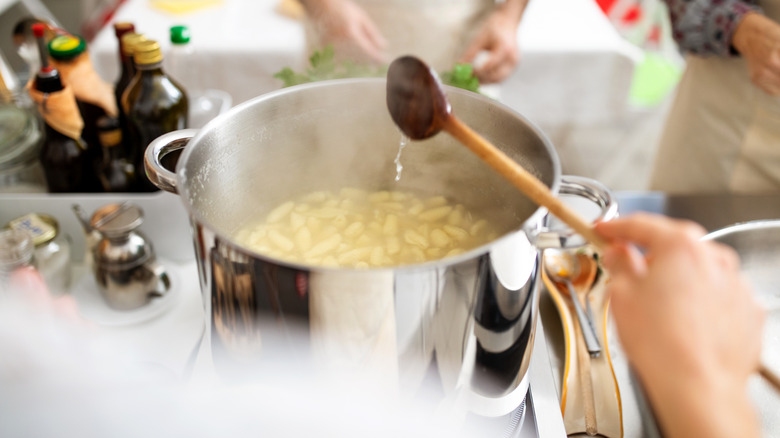
Alvarez/Getty Images
When you buy mac and cheese at a restaurant, the pasta itself is treated properly. It isn't just an afterthought or a vessel for the sauce. Chefs make sure they're boiling it in water that's properly salted. It's not just a pinch you need, it's more like a small handful. It's more common to under-salt than oversalt the cooking water, so be generous.
Salting pasta water is what gives the noodles themselves flavor. If the pasta is bland, the whole dish feels flat, no matter how good your sauce is. Most home cooks don't salt their water nearly enough, and it shows in the final dish.
The pros also make sure to undercook the pasta slightly. Instead of going to full al dente, chefs often pull the pasta a minute early. That way, it finishes cooking in the cheese sauce or in the oven, absorbing flavor as it goes and avoiding a mushy texture.
This technique gives you pasta that's more integrated with the sauce. The pasta isn't just sitting in the sauce, it has soaked it up. At home, it's tempting to drain the pasta when the timer says so and move on. But holding back just a little makes a big difference. You get that perfect texture your homemade mac may have been missing.
Chefs may add something tangy to their mac and cheese

Oksana Mizina/Shutterstock
Mac and cheese is rich, we all know that. But without a little contrast, it can veer into heavy territory fast. That's why many chefs add a small amount of something tangy to the mix — it brightens the dish and balances the flavors.
This might be a spoonful of sour cream, a touch of Greek yogurt, a splash of white wine, or even a few drops of vinegar or lemon juice. Some use Dijon mustard, which adds both tang and depth. Others turn to hot sauce for a little acid and heat in one go.
You might not notice it on your first bite, but it's there, cutting through the fat and giving the cheese more presence. Without that acidity, the dish can feel flat or one-note, no matter how much good cheese you use.
It's easy to overdo this step, so chefs are usually subtle. The idea isn't to make it taste like sour cream or yogurt. It's just to bring everything into better balance. That's often the way with great cooking. You're not trying to overdo it with the flavors, but rather carefully combine them to make something better than the sum of its parts.
Professional chefs use ingredients like mustard powder and Worcestershire sauce for extra flavor
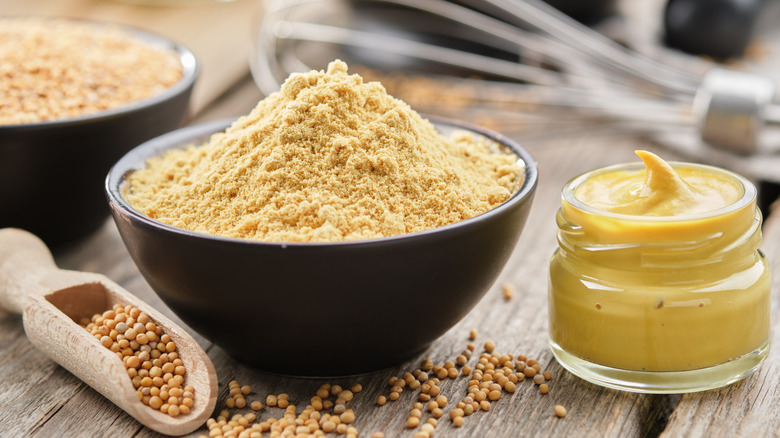
LN team/Shutterstock
If you've ever wondered why your mac and cheese tastes good, but your favorite restaurant version tastes like it has more going on, you're probably missing something. Professional kitchens often build flavor in layers, using a few small, punchy ingredients that you might not expect in a cheese sauce.
A pinch of mustard powder is a classic example. It doesn't make the dish taste like mustard, but it adds a subtle sharpness that highlights the cheese. Worcestershire sauce is another behind-the-scenes ingredient. Just a few dashes can bring a savory, almost meaty depth to the sauce thanks to its mix of vinegar, molasses, anchovy, and tamarind. Garlic powder, paprika, bay leaf, and cracked black pepper might also show up in the background.
At home, we often let the cheese do all the work, but these little additions create more complexity without overpowering the dish. If your mac feels like it's missing something, try experimenting with just a pinch of mustard powder or a dash of Worcestershire sauce. You probably won't taste them outright, but you'll taste the difference they make.
Restaurant mac and cheese may contain onion
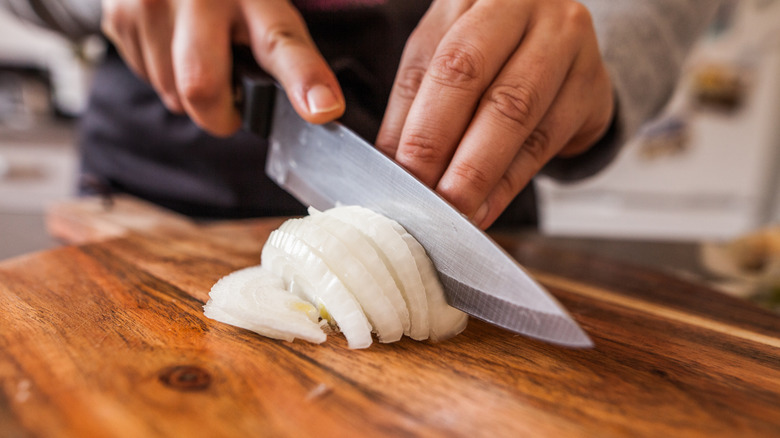
Capelle.r/Getty Images
Onion might not be the first thing that comes to mind when you think about mac and cheese, but don't be surprised if your favorite restaurant version quietly includes it. It's not always obvious, but it's often in there, adding sweetness, depth, and another layer of savory goodness.
Chefs might start their béchamel by sautéing finely chopped onion in butter. Others may infuse the milk with onion before making the roux. And some simply add a bit of onion powder for a hit of umami without any texture.
The idea isn't to make it taste oniony — it's about layering flavor. A small amount of cooked-down onion brings a gentle sweetness and a savory note that pairs beautifully with cheese. You might also see leeks, shallots, or garlic used in the same way. Each adds its own flavor, but they all help round out the base of the sauce.
If you're making mac and cheese at home and it feels a little flat, try sweating half a small onion in butter before adding your flour. Make sure to finely dice it so it isn't too prevalent in the sauce. It won't take over the dish, but it will give your sauce more dimension, and might just make your mac feel more restaurant-worthy.
Chefs put something crunchy on top of their mac and cheese
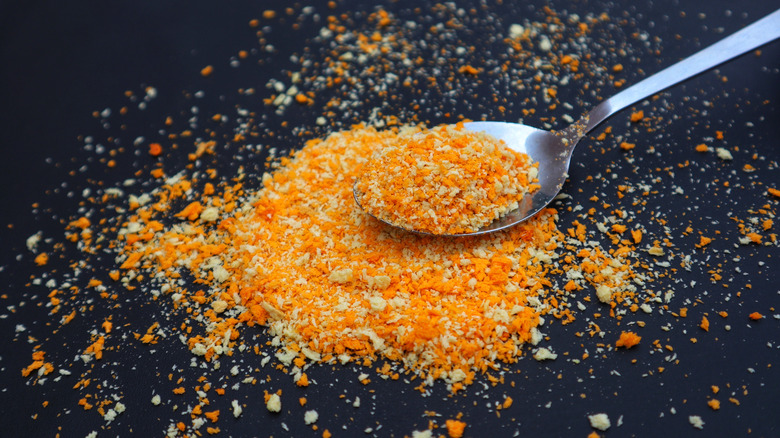
Evelyn Smj/Shutterstock
The golden, crispy topping on restaurant mac and cheese isn't just so it looks good. It's part of the beauty of a great example of the dish. That contrast between the creamy interior and the crisp top is a big reason why it feels special.
Chefs get that texture by finishing the dish under the broiler or baking it with something crunchy layered on top. Breadcrumbs are the obvious choice, but chefs may also experiment with crushed crackers, crumbled potato chips, toasty garlic chips, or chopped nuts. The goal is to provide some contrast to the creaminess of the dish.
You'll also find restaurants getting creative here, seasoning the breadcrumb mixture or adding extra ingredients. Garlic, Parmesan, and fresh herbs like sage or rosemary are all delicious additions. A drizzle of olive oil or melted butter also helps to finish things off.
When you're making mac at home, it's easy to skip the topping altogether, especially if you're in a rush. But adding even a handful of breadcrumbs and giving it a few minutes under the grill can totally change the experience. Don't skip the topping if you want a mac and cheese that stands up against your restaurant favourites.
Chefs may bake their mac and cheese
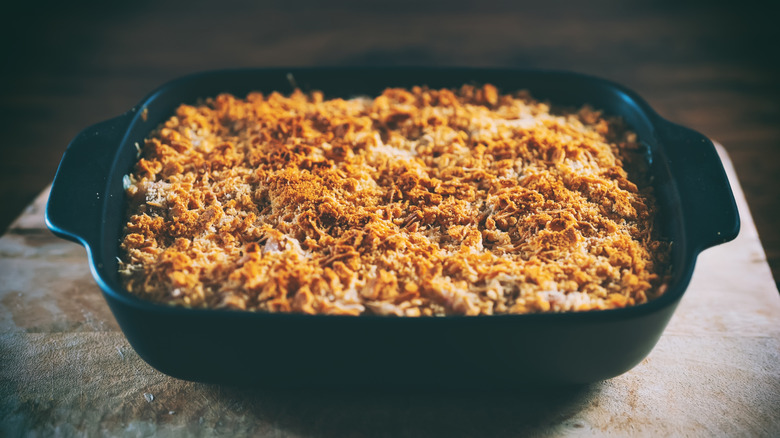
M-Production/Shutterstock
While stovetop mac and cheese has its place — especially when time is tight — restaurant versions are often baked. It might not seem like much but it's a step that makes a big difference.
Baking does more than just warm the dish through. It helps the sauce thicken slightly and meld with the pasta. It also gives the top layer a bit of structure, especially if there's cheese or breadcrumbs sprinkled over it. That top layer turns golden and bubbly, so you get the kind of texture you don't get from a pot on the stove.
It's also a smart move from a restaurant perspective. Baking allows chefs to prep mac and cheese in advance, portion it out into dishes, and reheat it to order without sacrificing quality. It gives the dish that cozy, casserole vibe that's part of its nostalgia for many.
Baking might seem like an extra step, but it's worth it. Just remember to keep things saucy, because pasta continues to absorb liquid as it bakes. No one wants dry mac and cheese. If you want to take your version up a notch, try assembling it in a baking dish and popping it in the oven for 20 minutes. Plus, there are plenty of baked mac and cheese recipes to follow, to make sure you get those noodle-to-sauce ratios right.



